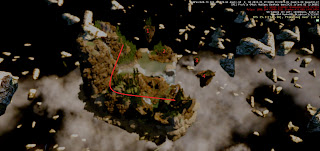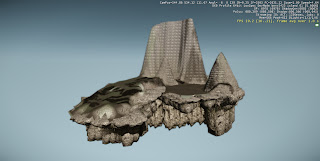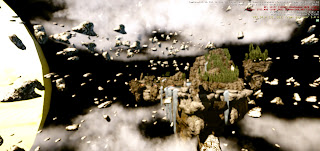skip to main |
skip to sidebar
Strategy Statement:
See Abandonment blog post
5 Draft CryEngine environment Images
Files to play test environment + 3ds Files:
(note: 3ds files are in the Objects folder)
Level name for new Bordeaux: BENV2423_MAISON_BORDEAUX_01_editor
Level name for Bordeaux on Fire: BENV2423_MAISON_BORDEAUX_BROKENUP_editor
Level name for Bordeaux decayed: BENV2423_MAISON_BORDEAUX_DECAY_editor
https://www.dropbox.com/s/7dw4ko13ba4pclp/BENV2423_EXP2_z3329964.zip
Video Clip:
https://www.youtube.com/watch?v=sT7WJ6jJ0ck
For this section, I want to illustrate the Bordeaux house breaking apart at the critical point. The critical point here is the midway point between two distinct sections of the house:
The house was originally made for a man in a wheelchair. Koolhaas designed a lift for the man, so as to ease mobility. The right side of the house, dominated by the square of the lift, became a zone easily accessible to the man. The left side, dominated by the cylinder, was restricted to persons who could climb the laborious spiral stair.
Thus, the design of the house was based on a theory of inclusion and exclusion. I wanted to exaggerate this by having the house split down the middle, with one section on land and the other in water. The section on land is to be seen on fire, due to the destruction at hand. This will further emphasise the polarity between the two sections - disabled/abled, square/circle, fire/water.
APPLYING SPECULAR AND BMP MAPS
I have added specular and bump maps for materials used so far in the modelling of the Maison Bordeaux. This has added depth to the realism of the design:
HOW MATERIALS CORRODE
The Maison Bordeaux has three main elements - concrete, steel and glass. Each element is made differently, corrodes differently and has different life spans.
Glass:
Glass is made from a base of silica (sand) with other materials added depending on the desired properties of the glass. The materials are then heated to a very high temperature and fused together. In a state of decay, glass does not decompose or decay. However, because of its fragile state it is expected to crack and break as the rest of the building shifts around due to the decaying process.
Steel:
Steel is made from iron ore and melted with other materials. It is used in buildings for its tensile and compressive strength. In the Maison Bordeaux, steel has been used throughout to add strenght to the structure. It is evident in the main beam, the I beam on the roof and it also would have been used in the reinforcing of the concrete features. If left unmaintained, steel will rust and corrode over time. Structural systems made from steel would fail as the steels strength is hampered by the rust. It is expected that, due to the Bordeaux's fragile structure, once one of the steel parts fail, the rest would follow.
Concrete:
Concrete is made by mixing sand and other substances together, and cures through the use of water. Concrete is used in buildings for its compressive strength as well as a fire-proofer for steel construction. In the Maison Bordeaux, concrete is used throughout - in the floors, walls, ceilings. It is expected that the concrete in the Bordeaux would feature steel reinforcing. Concrete fails through exposure to the weather, most importantly rain/water. It is expected that after 100 years, the concrete in the Bordeaux would deteriorate significantly.
THE THREE HOUSES:
Barcelona Pavilion
Architect: Mies van der Rohe
Year: 1929
Structural System: steel beam and post system, with cladding added to cover skeleton structure. Sleek aesthetic to represent the modernist movements beliefs.
Maison Bordeaux
Architect: Rem Koolhaas
Year: 1995
Structural System: a combined structural system of cylindrical post, concrete facade, metal beam in compression and metal beam in tension. This complex structural system was meant to represent the fragility of the human spine.
Rudin House
Architects: Herzog and Demeuron
Year: 1996
Structural System: metal post and beam house clad in concrete
MAISON BORDEAUX - EXPORTING EXPERIMENTS
I have modified the model of the Maison Bordeaux so as to fit in better in my own environment. I wanted to place the model near the water, with the cantilevering end overlooking the water. I did this by mirroring the base of the model in sketchup, and tracing this new form:
the FINAL SUBMISSION
1 x STRATEGY STATEMENT
With the creation of my Island, I wanted to explore ideas of the Picturesque in order to create a Sublime image. The notion of 'the Sublime' - "greatness beyond all possibility of calculation, measurement or imitation" - was traditionally used to depict the natural world around us. I wanted to explore this in an expanded definition of 'the natural world' by applying it to ideas of space outside of the limits of the Earth.
The hiding of the letters and number combination was achieved using a minimal approach. The letters are initially hidden throughout the island using small blocks disguised amongst rubbish and other goods. The "grounded" nature of the numbers (hidden on the ground) is slowly replaced by a focus on the sky (the numbers hidden in the rocks, as well as the final image - the C shaped island with 4 free-floating bodies). This notion is further reinforced in the trailer, where the initial shots are of the landforms of the island, with the free floating nature emphasized as the trailer progresses.
5 x IMAGES OF DRAFT CRYENGINE ENVIRONMENTS
1 x MOVIE TRAILER
The opening scene, featuring the collision of the two planets, was taken from the Lars von Trier 2011 film 'Melancholia'.
The music is the opening 2 minutes of Wagner's Tristan und Isolde - Prelude. The links to the youtube videos from which these two were taken are as follows:
Video:
http://www.youtube.com/watch?v=e-WNBsp15Bc
Music:
http://www.youtube.com/watch?v=fktwPGCR7Yw
1 x FULLY DEVELOPED CRYENGINE 3 ENVIRONMENT
https://www.dropbox.com/s/fa077vvnd9b0yr2/BENV2423_z3329964.zip
the SUBLIMINAL
The hiding of the letter and number combination. I hid them as parts of the scenery, using mainly very obvious type fonts.
I wanted the hiding to be very simple, and hidden amongst the junk of the various 'stations'. The "subliminal" aspects of the island are thus tied in strongly with the presence (and lack of presence) of humanity on the island. This would thus highlight the Sublime nature of the level, as the letter/number's hint at a human population now long gone.
DRAFT SUBMISSION
1 x STRATEGY STATEMENT
see above
5 x IMAGES OF DRAFT CRYENGINE 3 ENVIRONMENT
1 x 120 SECOND VIDEO TRAILER
http://youtu.be/IlPYqbNGwRs
COMMENTS ON LECTURE
I find it very interesting that the beginnings of exploration into 'the subliminal' were tied in with advertising and encouraging the masses to buy more than they nee.d
the SUBLIME
Space is the final frontier. Greatness beyond all possibility of calculation, measurement or imitation.
Creating the Drama in the CryEngine editor:
Creating a body floating in space is made more difficult by the fact that CryEngine uses skymaps to create atmospheres. These work perfectly well with normal levels, where the horizon is obscured by water or land. However, with a floating island, the difference between the skymap and the 512x512 land is very obvious:
The only way to overcome this situation, was to use a black fog on both the bottom and the top of the game play. This hides the contrast between the top and the bottom. However, it also hides any skymaps which might have been placed in, so the night sky with the stars is also hidden. Thus, this just leaves a plain black surrounding.
The effect of 'being in space' was created by scattering floating rocks around the island, to make it appear to be in some sort of asteroid belt. This effect was heightened by adding cloud entities above and below the island (i.e. space dust).
Olafur Elliason - THE WEATHER PROJECT
The drama of a large, elusive yellow ball is used in my island as a remnant and reminder of Earths collision with the rogue planet. The double-orb created by the Cryengine Editor as it tries to render an object so far away adds further drama to the scene.
The presence of a large floating orb obscured by fog.
Turner - FISHERMEN AT SEA
To add to the sublime nature of the island, I used Turner's painting as a model for the level of contrast/saturation/gamma for my scene. I also wanted to portray what colour might look like in very thin atmosphere (as might be expected after a planet falls apart).
Saturation and colour settings edited for a more sublime effect:
VIDEO
http://www.youtube.com/watch?v=XxJTwV1yFNw&feature=youtu.be
LECTURE COMMENTS
I found it very interesting that the original definition of 'the Sublime' in art was strongly tied in with appreciation of nature and natural phenomenon.

































